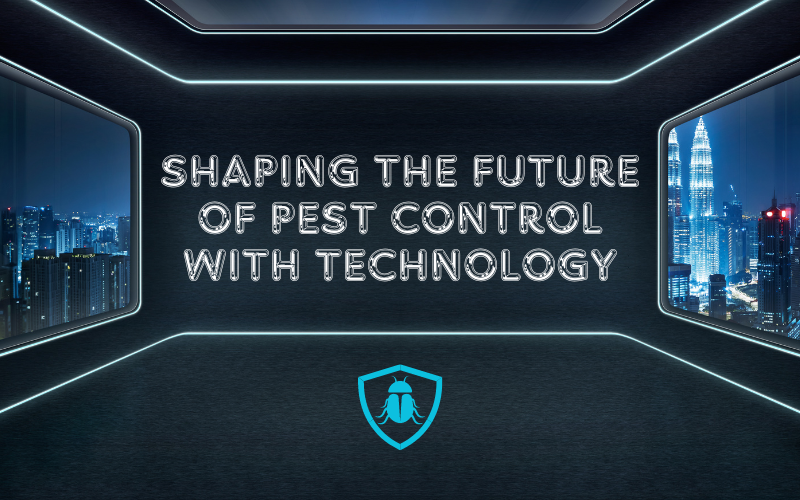
How Technology is Shaping the Future of Pest Control
02 Oct 2023Pest control, traditionally an area dominated by manual monitoring and chemical methods, is increasingly witnessing the marriage of tech innovations and ecological practices. As with numerous other sectors, technology offers tools that can elevate the accuracy, efficiency, and safety of pest interventions. In the dynamic urban environment of Singapore, a nation proud of its tech prowess and biodiversity, embracing such advancements is not just a trend, but a necessity. Let's delve into how these technological innovations are setting the trajectory for future pest control, aiming to strike a perfect balance between urban needs and nature's preservation.
1. Digital Monitoring and Detection
Beyond the primary functionality, modern digital monitors are designed with user-friendly interfaces, ensuring easy configuration and data interpretation. Integration with mobile applications allows remote monitoring, a boon for large establishments or multiple property owners. With advanced analytics, they can even provide insights into pest behavior, leading to more informed decisions about intervention timings and methods. Singapore's high-tech infrastructure, coupled with its push for smart cities, complements this digital shift, creating a synergy of urban planning and proactive pest management.
2. Drones in Pest Management
The precision and scalability offered by drones make them invaluable. They can quickly cover vast areas, providing high-resolution imagery that can detect even subtle signs of infestations, often missed by the human eye. Beyond mere detection, drones equipped with thermal imaging can identify potential breeding grounds based on heat patterns, especially useful for pests like termites. As drone technology advances, we might see enhancements like AI-powered image recognition for instantaneous pest identification, turning them into real-time pest surveillance machines over Singapore's cityscape.
3. Geographic Information Systems (GIS)
GIS's power isn't just in collecting data but also in visualizing it in a spatial context. This geographical mapping allows stakeholders to view infestation trends, facilitating a macro perspective. When merged with other databases, like public health records, GIS can also highlight correlations between pest outbreaks and health implications. For a country like Singapore, where space is a premium and urban planning is meticulous, GIS assists in efficiently allocating resources, ensuring areas of high vulnerability receive timely attention.
4. Internet of Things (IoT)
The beauty of IoT lies in its ability to create a network of interlinked devices, constantly communicating and sharing data. For pest control, this means an integrated system where data from one device can trigger actions in another. Imagine a scenario where a smart trap detects increased rodent activity, sending signals to nearby devices to increase monitoring or activate preventive measures. Singapore's robust digital infrastructure and its push for a 'Smart Nation' align perfectly with the integration of IoT in various sectors, including pest management.
5. Biopesticides and Precision Dispensers
Biopesticides represent the future of sustainable pest management. They target specific pests, reducing collateral damage to beneficial organisms. However, their effectiveness often depends on precise delivery. That's where technology comes in. Precision dispensers, equipped with sensors, can detect environmental conditions, adjusting the release of biopesticides to maximize effectiveness. For instance, a dispenser might release more of a product on a particularly humid day in Singapore, considering pests' increased activities. Such intelligent systems ensure that the fusion of biology and technology remains at the forefront of green pest management.
6. Artificial Intelligence and Data Analytics
While data provides a treasure trove of information, it's the power of AI that extracts meaningful patterns from this data. Machine learning models, trained on historical pest data, can forecast potential outbreaks based on a myriad of factors like weather patterns, urbanization rates, and public health trends. For a data-driven society like Singapore, the potential is immense. Predictive analytics can help allocate resources better, initiate public awareness campaigns, or even influence urban planning decisions, making AI a central pillar in the city's holistic pest management strategy.
Challenges and Considerations
Despite the apparent benefits, integrating technology into pest control is not without its obstacles. The initial financial outlay for such state-of-the-art systems can be daunting for businesses and public entities alike. Furthermore, there exists a tangible learning curve for pest management professionals adapting to these innovations, making continuous training and upskilling imperative. On the data front, with a multitude of IoT devices capturing a vast spectrum of data, concerns about privacy, security, and ethical usage come to the forefront. Proper data management protocols need to be established to address these issues. Nevertheless, when juxtaposed with the significant advantages of precision, swift response times, and environmental conservation, these challenges seem surmountable. Adopting a proactive approach in navigating these concerns will determine the successful and ethical employment of tech in pest control.
Looking Ahead
The nexus between technology and pest control in Singapore is indicative of a global trend. As urban centers worldwide grapple with the dual challenge of development and sustainability, tech-driven solutions offer a beacon of hope.
Moreover, as technology advances, we can anticipate even more groundbreaking tools. Perhaps we'll see nanotechnology playing a role, with microscopic bots identifying and neutralizing pests. Or maybe virtual reality will enable immersive training for pest control professionals, preparing them for real-world challenges. These innovations promise a future where pest control becomes increasingly efficient and environmentally friendly.
For now, the synergy between technology and pest control ensures not just a pest-free environment but also a sustainable, eco-friendly approach that respects the delicate balance of our ecosystems.
Conclusion
The infusion of technology into pest control is reshaping the sector, marrying innovation with traditional practices. In Singapore, a city that continually reinvents itself, this blend promises a future where humans, technology, and nature coexist harmoniously. The age-old battle against pests is getting a modern makeover, and the possibilities seem boundless. As Singapore's commitment to sustainability grows, so too will the evolution of pest management, leading to a greener and more harmonious urban environment.
